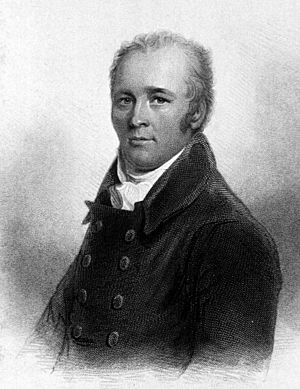James Currie (physician) facts for kids
James Currie (born May 31, 1756, in Dumfriesshire, Scotland – died August 31, 1805, in Sidmouth, England) was a Scottish doctor. He is remembered for two main things: helping to publish the poems of famous Scottish poet Robert Burns, and for his medical ideas about using water to treat fevers. He was also a strong supporter of ending slavery.
James Currie tried to start a business in Virginia, America, but it didn't work out. He then returned to Scotland and became a doctor. He built a very successful medical practice in Liverpool, England. He also joined important groups like the London Medical Society. Throughout his life, he faced health challenges. He passed away at the age of 49.
Contents
Early Life and Education
James Currie was born in Kirkpatrick-Fleming, a small place in Annandale, Scotland. His father, Reverend James Currie, was a minister. James went to school in the nearby parish of Middlebie and later attended the grammar school in Dumfries.
After spending some time in America (which we'll talk about next), he came back to Scotland in 1776. He began studying medicine at the University of Edinburgh. During his first year, he got rheumatic fever, an illness that bothered him many times throughout his life. He earned his medical degree in Glasgow and then moved to Liverpool in 1780. There, he became one of the doctors at the local infirmary (a type of hospital).
In 1783, he married Lucy Wallace. They had five children together. Lucy's family was well-off, and she was a descendant of William Wallace, a famous Scottish hero.
Adventures in America
When James Currie was young, he heard exciting stories about how easy it was to get rich in America. So, in 1771, he traveled to Virginia, which was a British colony at the time. He tried to become a merchant (a trader) along the James River. He spent five difficult years there. He was often sick, and his business never made much money.
Trade between Britain and America was getting difficult because of disagreements. James started to get involved in politics. He wrote articles defending Britain's right to tax its colonies, using the pen name 'An Old Man'. He was very open about his opinions, which probably didn't help his business.
When the American Revolution began, any hope of success for his business ended. He decided to sail back home to Scotland in the spring of 1776. However, his ship was captured by the revolutionary army! He was forced to serve in the Colonial Army, but he managed to buy his freedom. He tried to sail to England again, but he was captured a second time. This time, he had to sail 150 miles in a small, open boat to finally gain his freedom. He reached Deptford, England, on May 2, 1777.
Medical Discoveries and Water Treatment
Dr. Currie became well-known for his medical work. He successfully used cold water to treat a serious fever that was spreading in Liverpool. In 1797, he shared his ideas and experiences in a pamphlet called Medical Reports on the Effects of Water, Cold and Warm, as a Remedy in Fevers and Other Diseases.
This publication was very important because it encouraged the use of cold water treatments. It also contained the first detailed records in English of medical observations using a thermometer. This showed how scientific he was in his approach. Even many years later, in the 1840s, when there was a new interest in cold water cures (called hydropathy), people still recognized Dr. Currie's work. They saw his book as the "scientific base" for using water in medicine.
Helping Robert Burns's Legacy
James Currie was a big fan of Robert Burns's poetry. He even met the poet once in Dumfries. It turned out that one of James's wife Lucy's relatives, Mrs. Dunlop, was a very close friend of Burns. Burns and Mrs. Dunlop exchanged many letters over ten years, and 186 of them still exist today!
After Robert Burns passed away, James Currie was given the important job of publishing an official collection of his poems. Even though he had never done anything like this before, he had many advantages. Through Mrs. Dunlop, he could access original poems and letters. He also got help from Gilbert Burns, Robert's brother, and many of Burns's friends.
When The Complete Poetical Works of Robert Burns: With Explanatory and Glossarial Notes; And a Life of the Author was published in four books in 1800, it was an instant hit! New editions were quickly printed in 1801, 1802, and 1803. The collection included updated versions of Burns's songs, like "The Battle of Sherramuir." It also had an introduction with thoughts on Burns's work and an essay about the lives of Scottish farmers. This work is still considered a very important source for studying Robert Burns.


